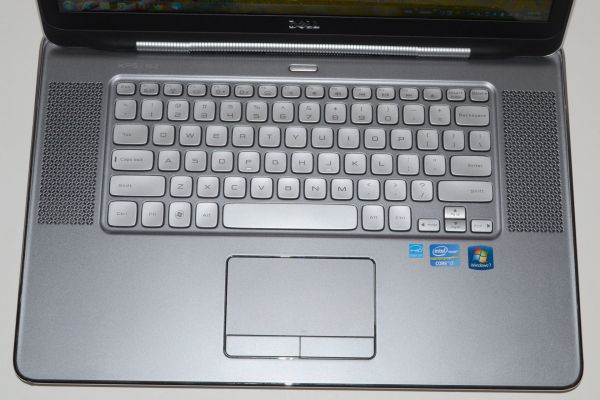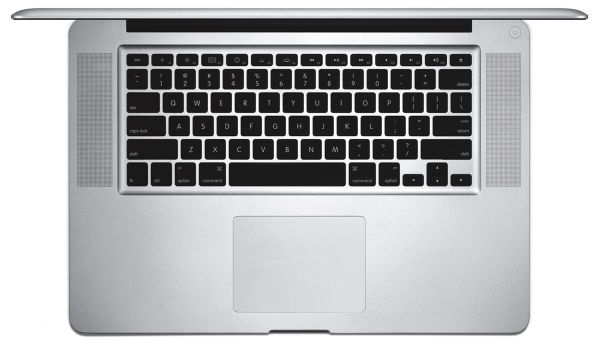Dell XPS 15z: Sincerely Flattering
by Jarred Walton on September 2, 2011 1:30 AM ESTDell XPS 15z: A Good Copy or a Cheap Clone?
If you’ve been living under a rock and happen to see the XPS 15z as the first laptop after emerging, there’s a lot to like and it would set a high bar for other laptops to clear. It’s thin, reasonably light, has plenty of performance for all but the most demanding tasks, and it gets good battery life. For the rest of us, however, it’s going to look a lot like a MacBook Pro 15. Here’s a gallery of the 15z.
 Dell XPS 15z Keyboard |
 Apple MBP15 Keyboard |
There are certainly similarities between the appearance of Dell’s XPS 15z and the MacBook Pro 15, so let’s cover where things are the same and where they’re different, since comparisons will be inevitable. Both are thin, have aluminum covers, and the new Dell keyboard layout bears a striking resemblance to the MBP15 layout. Home/End/PgUp/PgDn keys are accessed via Fn+Cursor key combinations, and there are large speaker grilles on the right and left of the keyboard. So far so good.
Where they’re different is in the shape of the keys on the keyboard, and then there’s the fact that the aluminum covers on the XPS 15z feel extremely thin and flexible, almost to the point where I’d think the covers are plastic (but they’re not). The palm rest also has some give, and I’m not sure if it’s plastic or aluminum. The MBP15 sports a unibody construction that adds to the rigidity where the 15z definitely has some flex. So if you’re after something that feels like a MacBook Pro but comes standard with all the Windows 7 goodness… well, this isn’t it. It’s decent, and overall I have no problems recommending it, but this feels more like a copy of a copy of the MPB15—with each iteration losing a bit of fidelity.
Other differences aren’t in Apple’s favor, however. There’s the 1080p LCD compared to a 1680x1050 or 1440x900 panel on the MBP. The quality of the MBP15 display is better, but it’s hard to argue with a higher resolution and the 15z panel at least has a decent contrast ratio and brightness. The 15z also comes with either 6GB or 8GB of RAM without fleecing you, something Apple is wont to do. Wrapping up the comparison, with Apple you get a quad-core CPU (it’s faster but can draw more power and thus run hotter than the dual-core SNB chips Dell uses in the 15z) and either an anemic Radeon HD 6490M or a faster HD 6750M. Dell gives you a GT 525M, which should somewhere between the two in performance, but closer to the 6750M than the 6490M—not to mention gaming happens to be a stronger area on Windows than on OS X.
Given the price premium of the MacBook Pro 15, it’s safe to say that these laptops play in different leagues. Just as you’d expect a luxury sedan to offer more comfort and style than an inexpensive vehicle, the MBP15 wins out in style and build quality. If you’re not willing to pay north of $1500 and you don’t care to run OS X, however, it’s a safe bet that buying a MacBook is already out of the question. Let’s forget about the MacBook Pro then and focus on the XPS 15z and the previous XPS 15. The following gallery shows some comparison shots between the XPS 15 L502x and XPS 15z, along with a comparison of the 15z with the Clevo W150HRQ.
Compared to its big brother, the XPS 15 L502x, the 15z has a lot going for it. It’s thinner and lighter and looks more attractive. Gone is the bulbous casing and excessively rounded corners. Pricing is good, build quality is reasonable, and Dell still lets you upgrade to a decent 1080p display. The 15z also comes with a 64Wh battery integrated into the chassis, and battery life and relative battery life are substantially higher than the XPS 15. However, the XPS 15 has other advantages that become apparent once you start using it.
First, the speakers on the 15z don’t sound anywhere near as good as those on the XPS 15. The lack of a subwoofer is certainly part of the problem, but the extra thickness on the XPS 15 seems to provide a better starting point. Going back to the keyboard, I’m actually not happy about the copying of the MacBook layout. I really like the layout on the XPS 15, with Home/End/PgUp/PgDn keys in a column on the right. I also happen to use the “Menu Key” regularly on my PC, so I immediately noticed it was missing with the 15z (and for those of you who love keyboard shortcuts, Shift+F10 isn’t nearly as convenient). Eventually I adapted to being reasonably comfortable with the 15z layout, but I still prefer the layout on the XPS 15.
The final area where the XPS 15 wins out is in raw performance. In the quest to create a thinner chassis, something has to give, and with the 15z that something is performance options. The XPS 15 can be had with dual-core CPUs from the i5-2410M up to the i7-2620M, or quad-core processors from the i7-2630QM up to the i7-2820QM; the 15z in contrast comes with two options, both dual-core: three of the configurations use the i5-2410M while the top-end configuration comes with the i7-2620M. In single-threaded or lightly-threaded loads the i7-2620M (or even the i5-2410M) will be plenty fast, but for multi-threaded workloads there’s no beating more cores. The XPS 15 also supports an upgrade to the GT 540M, and while it’s only clocked about 10% higher than the GT 525M that’s still something. Lastly, the 1080p LCD on the XPS 15 is better than the 15z panel—it has better color accuracy and color gamut, with slightly higher contrast.
Something else to consider with the XPS 15z is that upgrading the RAM or HDD is more difficult than on many other laptops. Sure, there’s the XPS 15z Service Manual, which even has detailed instruction for removing the base cover. Well, let me just say that after trying for 15 minutes to remove the base cover, I was ready to call it quits. When I got to the part where you’re supposed to “use your fingertips to release the tabs on the base cover from the slots on the palm-rest assembly”, it’s more difficult than it sounds and you feel like you might break something. Eventually I did manage to pry off the cover by using a small plastic card and starting on the side with the connector bezel, though I might have left a few marks on the casing in the process. Anyway, consider yourself warned: getting at the hard drive and/or RAM will require a bit of work. The above gallery has a few shots of the internals as the fruit of my efforts. You can see things are well laid out with very little in the way of empty space, but getting to that space will require some finesse.




























76 Comments
View All Comments
vol7ron - Friday, September 2, 2011 - link
http://store.steampowered.com/about/ This is the image that stands out.tag12171 - Wednesday, September 7, 2011 - link
Really? The OS never freezez on me and never crashes. Maybe you have a bad one. I would return it or find out what is wrong with it.tipoo - Friday, September 2, 2011 - link
Yeah, its closer to the 6530M.http://www.notebookcheck.net/Mobile-Graphics-Cards...
And with a chip of this calibre, yeah, 2GB isn't going to help you much in games. 1GB should be fine for it.
JarredWalton - Friday, September 2, 2011 - link
Edited the statement. You're right that the 6750M is a fair bit faster than GT 525M -- it's around the GT 555M I'd guess. I was thinking of the 6570M when I wrote that, though with OSX you're still likely to get lower than GT 525M performance if you compare something like Portal 2 FPS between the two (unless something has significantly changes since the last we looked at it?)sean.crees - Friday, September 2, 2011 - link
No Thunderbolt port? Sorry, not getting my money without at least one. External desktop grade graphics are just around the corner, and without thunderbolt your going to be stuck with your middle of the road non upgradable mobile graphics.tipoo - Friday, September 2, 2011 - link
True, but it will still be some time before it takes off. The fact that all of its ports are USB 3 (minus the e-sata USB combo port I think) is a redeeming quality though.retrospooty - Friday, September 2, 2011 - link
Thunderbolt? I doubt we will ever see that on a lot of products. USB3 is plenty fast enough for anything out there for the next several years, is cheap and backwards compatible. The industry has absolutely zero reasons to pick up Thunderbolt, and likely never will.darwinosx - Friday, September 2, 2011 - link
Heh, Right. I suggest you take a look at what Thunderbolt offers and how it blows USB 3 out of the water. There is a flood of products coming as well.jabber - Friday, September 2, 2011 - link
Were we not supposed to get all those kind of exciting things for laptops over 5 years ago with PCI-E card slots on laptops?Nope didnt happen so I wont hold my breath.
Plus those really pricey Thunderbolt cables...owwww!
That'll be the $1 USB3.0 then.
Thunderbolt is dead in the water.
AssBall - Friday, September 2, 2011 - link
What exactly are you using that is going to saturate your USB3?There are things that can, but ffs only 1 percent of people are going to use it on a consumer laptop.
If you are doing huge commercial or industrial data transfer fine, but most people looking at a Dell or Mac consumer notebook aren't those folks.